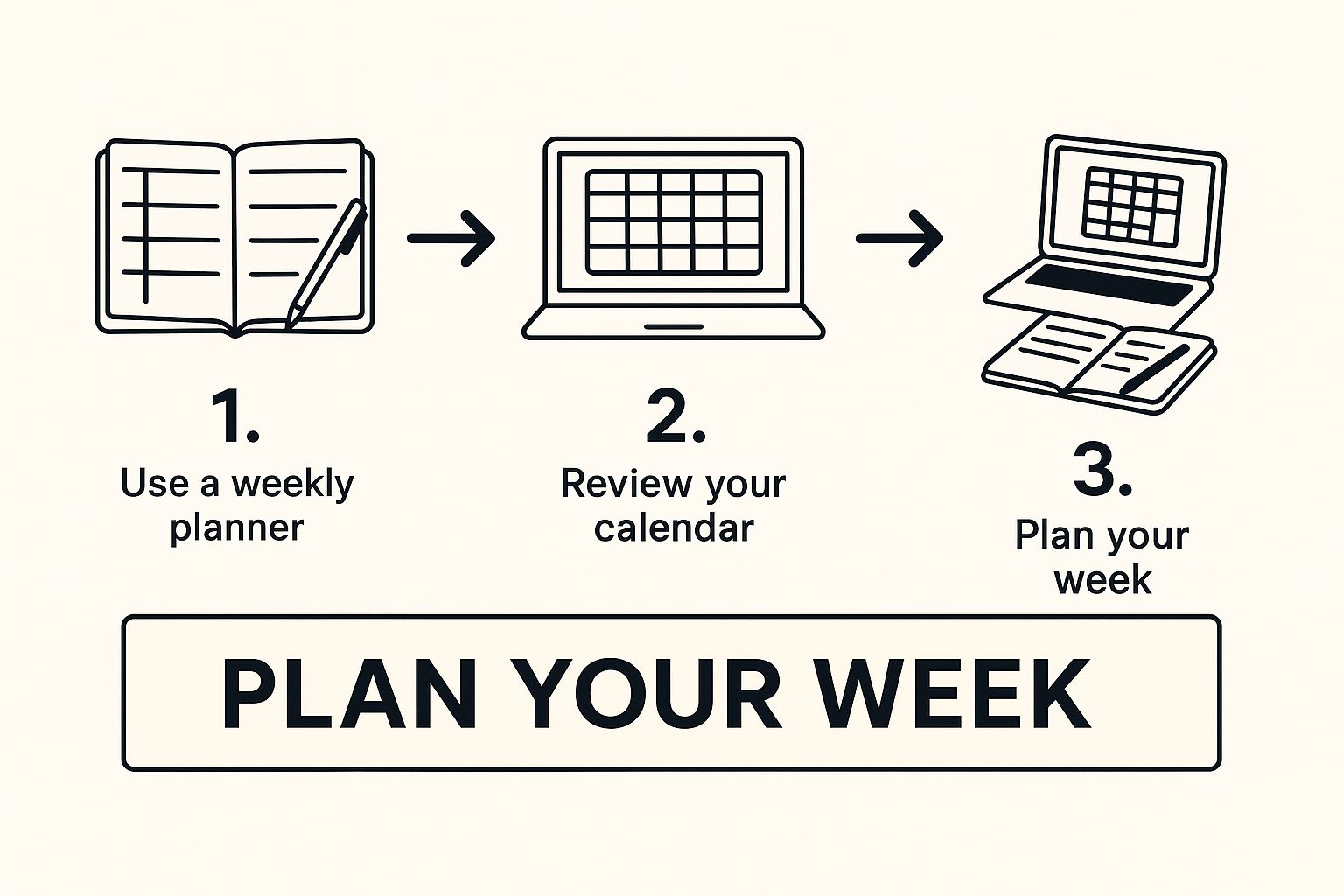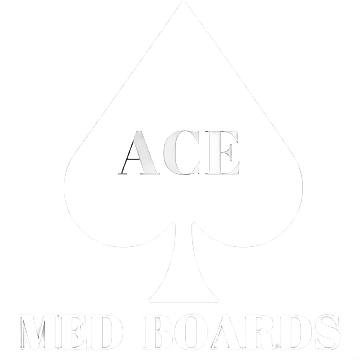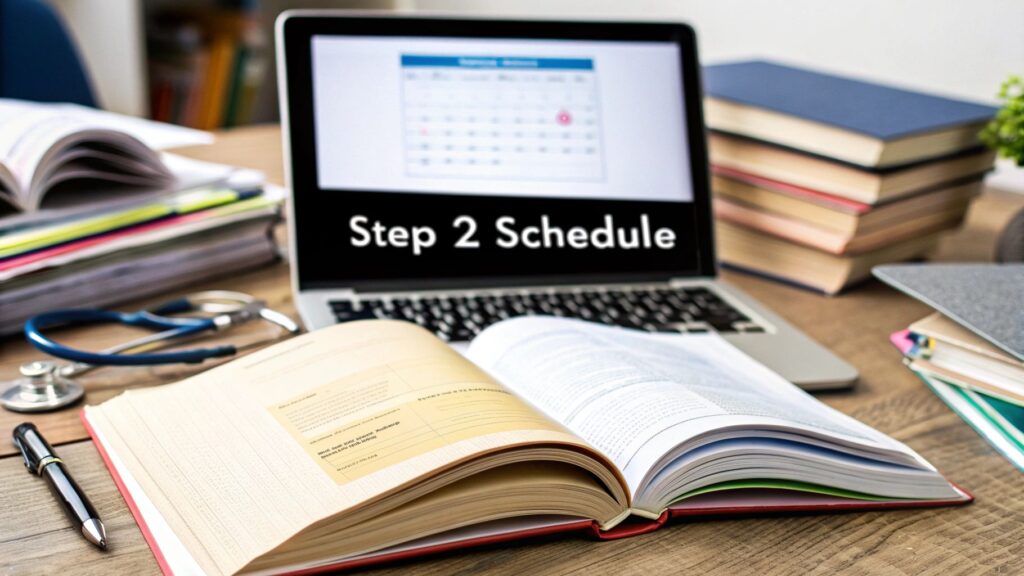A successful Step 2 study schedule is so much more than a calendar jammed with tasks. It's your personalized roadmap, one built on a bedrock of honest self-assessment and smart, strategic planning. The best plans aren't slapped together during your dedicated period; they're thoughtfully crafted before you even start, beginning with a crystal-clear understanding of your strengths, weaknesses, and ultimate score goal.
Building Your Foundation for Step 2 Prep

Before you start mapping out your days and weeks, you need to pour a strong foundation. This initial phase is all about getting real with yourself and setting expectations that won't lead to burnout. A well-built foundation ensures your schedule is not just robust but also flexible enough to handle the inevitable curveballs this demanding period will throw your way.
Assess Your Performance Honestly
Look, your clerkship and Shelf exam performance are the most valuable data points you have. Don't just glance at the scores; you need to dig into the feedback. Did you consistently bomb cardiology questions but absolutely crush it in pediatrics? This isn't a casual observation—it's the literal blueprint for where to invest your precious study time.
Fire up a simple spreadsheet or even just a notebook and track your performance across the core rotations:
- Identify Strengths: These are the subjects where you scored well and feel genuinely confident. They'll need less intensive review.
- Pinpoint Weaknesses: These are the areas where your scores lagged or where you consistently felt lost. Make these your top priority.
- Note Mixed Areas: What about topics where you did okay, but not great? These probably need a solid content review before you start hammering question blocks.
This kind of self-audit is what turns that vague, panicked feeling of "I'm bad at medicine" into a concrete, actionable plan like, "My main focus needs to be nephrology and endocrinology."
Set a Realistic Score Goal
Your target Step 2 score needs to be grounded in reality, balancing your specialty dreams with your current performance. First, research the average Step 2 CK scores for residents in the specialties you're considering. This gives you a tangible number to work toward.
But you have to be honest with yourself. If your baseline practice exam score is a 220, aiming for a 270 in just four weeks is a surefire recipe for burnout. A much healthier and more practical approach is to aim for a challenging yet achievable improvement, like 15-20 points over your baseline. This keeps you motivated without piling on crushing, unrealistic pressure.
Key Takeaway: A well-defined score goal transforms your study process from a fuzzy "review everything" slog into a targeted mission. It dictates the intensity of your schedule and helps you decide if you're aiming for a solid pass or a highly competitive score.
Pre-Dedicated vs. Dedicated Study Periods
It’s critical to understand the difference between studying during your rotations and entering your "dedicated" study period. Many students get some informal Step 2 exposure during their third-year clerkships, which is great. But the focused 4-6 week dedicated period is where the real magic happens and where you'll see the most significant score jumps.
This is the time designed for grinding through question banks, locking in details with tools like Anki, and building the sheer endurance needed for exam day. If you're wondering how to structure this period, you can find more insights on crafting your study timeline here.
The two phases have fundamentally different goals and demand entirely different mindsets.
Comparing Pre-Dedicated vs Dedicated Study Phases
This table breaks down the primary goals, daily focus, and essential resources for the two main phases of your Step 2 CK prep.
| Phase | Primary Goal | Daily Focus | Key Resources |
|---|---|---|---|
| Pre-Dedicated | Build a knowledge base | Complete rotation-specific tasks and questions | Clerkship materials, subject-specific Anki decks |
| Dedicated | Integrate knowledge and master test strategy | Complete timed, random UWorld blocks and review | UWorld, NBME practice exams, comprehensive review books |
Recognizing this distinction is key. It helps you shift gears smoothly from the marathon pace of clerkship studying to the high-intensity sprint of dedicated prep. This ensures your step 2 study schedule is not just effective but also sustainable.
Designing Your 4 to 6 Week Dedicated Study Plan
Alright, this is where the rubber meets the road. Your dedicated study period, which usually lands somewhere between 4 to 6 weeks, is the time you shift gears from casual learning to a full-on, focused assault on this exam. Don't even think about using a generic template. The most effective step 2 study schedule is one you build from the ground up—one that fits your life, your weaknesses, and your energy levels.
The mission here is to create a solid framework that's still flexible enough to prevent you from burning out. This period isn't about cramming brand-new information. It’s about integrating what you already know, mastering the art of the question, and building the mental endurance for a grueling 9-hour test day.
This image really captures the weekly rhythm you should be aiming for. It's a constant cycle of planning, executing, and then tweaking your approach based on what's working and what isn't.

Think of your study plan as a living document, not something set in stone. You have to adjust it based on your practice scores and, just as importantly, how you’re feeling.
Structuring Your Study Days
One of the quickest ways to crash and burn is to schedule every single minute of your day. It’s a recipe for disaster. Instead, organize your days into productive blocks. This approach lets you get into a state of deep work without completely sacrificing your sanity.
Here’s a daily framework that I've seen work time and time again:
- Morning Block (4 hours): Hit your hardest task first thing. This is the perfect time for a timed, random 40-question UWorld block. Follow it up with a meticulous review of every single question—yes, even the ones you got right.
- Lunch & Recharge (1-1.5 hours): Actually step away. Seriously. Don't look at flashcards while you eat. A real, genuine break is non-negotiable if you want to have any focus left for the afternoon.
- Afternoon Block (4 hours): Dive into focused content review based on the weak spots you found in your morning Qbank. Or, if you’re feeling up for it, tackle a second question block to build your stamina.
- Evening (1-2 hours): Keep this time for lighter tasks. It's a great slot for catching up on your Anki reviews or watching a few videos on a topic that gave you trouble. And then, you stop. Your brain absolutely needs that downtime to consolidate everything you learned.
A productive day is not about staring at a book for 12 hours straight. It's about getting in 8-10 high-quality hours focused on clear goals, like completing and thoroughly reviewing a specific number of questions.
Mapping Out Your UWorld Pass
Your question bank—and let’s be real, that mostly means UWorld—is the absolute backbone of your study schedule. The primary goal during your dedicated period is to finish your first pass and then move into a smart, targeted second pass.
If you have about 3,800 questions to get through in a 5-week (35-day) window, the math says you need to do about 108 questions per day. That’s nearly three full blocks, which can feel relentless. A more sustainable pace for many is aiming for two blocks (80 questions) daily. It might stretch out your first pass a bit, but it gives you so much more time for a deep, meaningful review.
A winning strategy usually looks something like this:
- Start with Systems: For the first week or two, do your blocks by system (Cardiology, then Pulmonology, etc.). This helps build a solid foundation and gives you a confidence boost in the major areas.
- Switch to Random, Fast: After that initial phase, you need to switch to timed, random blocks. This is non-negotiable. It’s the only way to simulate the real exam, forcing your brain to jump between topics just like it will have to on test day.
- Be Smart About Your Second Pass: A full second pass of UWorld is often a waste of time. It's much more efficient to create custom blocks from all your incorrect and marked questions. This directly targets your knowledge gaps and is a far more powerful use of your precious final weeks. If you want to dive deeper into different study methods, check out our guide on how to study for Step 2 CK.
Scheduling Practice Exams
Practice exams are your reality checks. They’re essential for tracking your progress, nailing down your pacing, and building the stamina you need for the real thing. Don't just take them whenever—schedule them strategically to get the most out of them.
Here's a sample schedule for your NBMEs:
| Week | Exam | Purpose |
|---|---|---|
| Week 1 | Baseline NBME/UWSA1 | Get a starting score and pinpoint your biggest weaknesses right away. |
| Week 3 | Mid-Point NBME | Check your progress. Is what you're doing actually working? |
| Week 5 | Final NBME/UWSA2 | Get a final score prediction and walk into the exam feeling confident. |
| Final 3-5 Days | Free 120 | Get a feel for the style of questions written by the actual test makers. |
After every single practice exam, you must block out at least half a day for a thorough review. I mean it. The review is just as crucial as taking the test. Digging into your performance gives you invaluable data to fine-tune the final weeks of your step 2 study schedule and maximize your score.
Optimizing Your Resources and Question Strategy

Let's be honest. Having access to UWorld, Amboss, or Divine Intervention Podcasts doesn't guarantee a high score. Your resources are only as good as the strategy you use to deploy them. This is where you shift from just doing the work to thinking like a test-prep tactician, turning passive learning into an active, score-boosting machine.
The real backbone of a successful step 2 study schedule is using data from your question banks to drive your content review. It’s not about mindlessly checking off questions; it's about what you learn from every single one you get right and wrong.
Mastering Your Primary Question Bank
For nearly everyone, UWorld is the central pillar of Step 2 prep. But just grinding through random blocks day after day isn't the most effective path. You need to be intentional. There's a right time and a right way to use its different modes.
- Tutor Mode (First 1-2 Weeks): When you're just starting dedicated prep or diving into a new subject, system-based tutor mode is your best friend. It lets you build a solid foundation without the pressure of a ticking clock, allowing you to immediately connect a question to the concept you just reviewed.
- Timed, Random Blocks (The Majority of Prep): After you’ve built that initial foundation, you must switch to timed, random blocks. This is non-negotiable. It’s the only way to simulate the real exam, forcing you to jump between disciplines and get comfortable with the relentless pace.
The sheer volume of questions you tackle makes a huge difference. Research shows that completing at least 4,000 practice questions is strongly linked with higher Step 2 CK scores. The same study points to a focused prep period of 61 to 90 days, studying 8-11 hours daily, as the sweet spot for success.
Pro Tip: Make your UWorld notes brutally efficient. Instead of copying entire explanations, create a "one-liner" summary of the single most important learning point for each question you missed. This makes your review lightning-fast and laser-focused on the high-yield facts you didn't know.
Integrating Secondary Resources Without Overwhelm
It's so easy to get buried under a pile of resources. Every classmate has a "must-have" tool they swear by, and soon you're juggling three question banks, four video series, and five podcasts. The key is strategic integration, not just piling on more work.
Think of your secondary resources as specialist tools. You call them in for targeted strikes, not for broad, sweeping campaigns.
Here's a real-world scenario: You just finished a UWorld block and notice your score plummets every time a biostats or ethics question pops up.
- Your Action: Instead of just hoping for more biostats questions in your next random UWorld block, you dedicate a specific afternoon to the Amboss biostats section or listen to the relevant Divine Intervention podcasts. You use that secondary resource to fix a specific weakness you’ve already identified.
This approach keeps you from feeling like you have to complete every resource from cover to cover. It respects your time and focuses your energy where it will actually move the needle on your score.
Turning Performance Data into Actionable Insights
The analytics page in your question bank is a gold mine. Don't just glance at your overall percentage and move on. You have to dig in.
Here’s a practical way to break down the data and decide what to do next:
| Metric to Analyze | What It's Telling You | Your Actionable Step |
|---|---|---|
| Performance by Subject | These are your biggest content gaps. | Dedicate your next content review day to your bottom two subjects. No excuses. |
| Performance Over Time | Is your score trending up, hitting a wall, or dipping? | If you've plateaued, it's time to change something. Try a new resource, focus on flashcards, or do more questions on your weakest topics. |
| Timed vs. Untimed Scores | This tells you if you're struggling with pacing. | Prioritize doing only timed blocks. You need to build speed and confidence under pressure. |
By checking these metrics regularly, you let the data tell you exactly what to study next. This data-driven mindset ensures your step 2 study schedule is a living document that evolves with you, making it a truly personalized and powerful tool. For more ideas on refining your study methods, check out our comprehensive medical exam study tips.
A Word for IMGs and Repeat Takers
The road to a high Step 2 score looks different for everyone. For international medical graduates (IMGs) and those retaking the exam, the journey often has its own unique twists and turns. A standard four-week dedicated period just might not cut it, and your mental game needs to be on point.
Acknowledging that your path is different is the first step. It's not about frustration; it's about building a specialized Step 2 study schedule that sets you up for success.
Specific Strategies for International Medical Graduates
As an IMG, you're coming in with a medical education that might have stressed different clinical approaches or taught concepts differently than the USMLE expects. This isn't a weakness—it's just a difference you need to bridge strategically.
The single biggest factor for most IMGs is time. You’ll almost certainly need a longer dedicated study period than a U.S. med student, often somewhere in the three to six-month range, or even longer. This isn't a disadvantage. It's a strategic move that gives you the space to:
- Close Clinical Gaps: Use that extra time to live in resources like UWorld and Amboss. You need to master not just what the right answer is, but the why behind U.S.-based clinical reasoning and management.
- Master the Nuances: Dig into the ethics, patient communication, and healthcare system questions. These are often second nature to U.S.-trained students but can feel like curveballs if you haven't been immersed in that environment.
- Build True Confidence: A longer timeline means less daily pressure. This allows for a more methodical and less frantic review, which is how you build real, unshakable confidence.
This approach is crucial, and the numbers back it up. For 2023-2024, first-time takers from U.S. and Canadian schools saw a 98% pass rate. For non-U.S./Canadian graduates, it was 89%. The gap gets even wider for those repeating the exam, which just highlights how critical a solid, well-thought-out plan is. You can see more on these USMLE performance statistics yourself.
A New Framework for Repeat Takers
Staring down Step 2 for a second time is tough. It’s a heavy weight, both academically and emotionally. The biggest mistake you can make is just doing the same thing again, but harder. A successful repeat attempt demands a complete reset, and it all starts with a brutally honest look at the data.
The goal isn't to study harder; it's to study smarter and, more importantly, differently. Your last attempt handed you the most valuable tool you could ask for: a detailed score report that is a literal map of where you need to go.
Here’s how you build your new plan:
- Do a Deep Dive on Your Score Report: Don't just glance at it. Your new blueprint is right there in the performance bars for each subject. Those areas with the lowest performance? That's Priority Number One.
- Radically Change Your Study Methods: If you spent months passively watching videos, your new schedule needs to be built around active learning. This means timed, random UWorld blocks from the very beginning. If you only reviewed your incorrects, now you must review every single question—corrects and incorrects. You have to change the process to change the outcome.
- Confront the Psychological Game: It’s okay to be disappointed. Acknowledge it, but don't let it become the theme of your prep. Find a mentor, a tutor, or a study group that can help you rebuild your confidence. Small, consistent wins—like finally seeing your score improve in a weak area—are what will build your momentum back up.
For anyone retaking the exam, the Step 2 study schedule is as much about rebuilding your self-belief as it is about shoring up your knowledge. By starting fresh with a plan based on cold, hard data and new strategies, you can break the old patterns and walk into that testing center with a new sense of control.
How to Sustain Momentum and Prevent Burnout
Let's be honest. The intense, relentless focus required by a Step 2 study schedule is a marathon, not a sprint. The real danger isn't one bad day or a poor practice score; it's the slow, creeping exhaustion that can completely derail weeks of your hard work.
Sustaining your momentum has less to do with raw willpower and more to do with smart, intentional self-preservation. You have to play the long game.
The cornerstone of preventing burnout is building non-negotiable breaks into your schedule from day one. These aren't rewards you earn for a good study session. Think of them as mandatory appointments with yourself, just as critical as a UWorld block. Without them, your cognitive performance will inevitably nosedive.
Schedule Mandatory Time Off
Your brain needs time to consolidate all that information and simply rest. Forcing it to run on fumes by studying 12 hours a day, seven days a week, is a recipe for disaster. The most effective schedules I've seen all have structured downtime built right in.
- Daily Disconnect: Set a hard stop time every single evening. When the clock hits 8 PM (or whatever time you choose), you are done. No more "one last video," no more quick flashcard reviews. This is your time for hobbies, family, or just unwinding on the couch.
- One Full Day Off: Pick one day of the week—Saturday or Sunday is common—and make it a completely study-free zone. This isn't a "catch-up" day. It's a day to sleep in, get outside, and do things that make you feel like a person, not just a test-taker.
These breaks aren't a sign of weakness. They are a strategic tool for maintaining elite performance over the long haul. Ignoring them is one of the fastest ways to hit a wall.
Manage Your Stress and Physical Health
Your mental and physical well-being are completely intertwined. If you neglect your body, your ability to learn and recall complex clinical information will suffer. Prioritizing your health isn't a luxury; it's a core component of effective exam prep.
Think of it this way: a well-rested brain with good nutrition and healthy blood flow from exercise is simply a more efficient studying machine.
Burnout is a serious risk for any student facing high-stakes exams. If you find yourself struggling with overwhelming stress or a persistent lack of motivation, it's critical to recognize the signs. For more on this, check out our dedicated article on identifying and managing USMLE exam burnout.
Beyond just taking breaks, you can incorporate other small habits. Many students find immense benefits of journaling to process the daily grind and emotions. Even just 10 minutes of writing can help clear your head and dial down the anxiety.
Reacting to Setbacks and Plateaus
It’s going to happen. You'll get a practice score back that’s lower than the last one, or your QBank percentages will stall for a week straight. The difference between a student who succeeds and one who burns out is how they react in these moments.
Scenario: You just got your UWSA1 score back, and it's 15 points lower than you were hoping for.
- The Burnout Reaction: Panic sets in. You immediately dive into a 14-hour study day, resetting UWorld and desperately trying to cram every weak subject at once.
- The Sustainable Reaction: You step away from the computer for a few hours. Acknowledge the disappointment, then come back and calmly analyze the score report. You identify your top two weakest areas and adjust your schedule for the next three days to focus specifically on them with targeted content review.
Plateaus are not a sign of failure. They are a signal that you need to change your approach. Often, the best way to break through a score wall isn't more hours, but a different strategy—or even a much-needed day off to reset. This kind of adaptability is what keeps your Step 2 study schedule a helpful guide, rather than a rigid prison.
Your Top Step 2 Prep Questions, Answered
As you dive into your Step 2 study schedule, questions are bound to pop up. It's totally normal. You want to know you're spending your time wisely and not falling into common traps. Let's tackle some of the most frequent questions I hear from students, with real, practical answers to keep you on track.
How Many Hours a Day Should I Actually Study for Step 2 CK?
This is the big one, isn't it? The magic number everyone wants. Forget what you hear about 12-hour marathon sessions—that’s a direct flight to burnout city. For most students in their dedicated period, the sweet spot is 8 to 10 effective study hours a day.
What does that look like? A productive day might start with a UWorld block followed by a deep, thorough review, which can easily take 3-4 hours. In the afternoon, you could tackle another block or pivot to targeted content review on a weak area for another 3-4 hours. Cap it off with an hour or two of lighter work like your Anki reviews.
The key word here is effective. It’s crucial to listen to your body. If your focus is shot, pushing through is just wasting time. Take real breaks. Get up, walk around, and let your brain reset. Quality always beats quantity.
When Should I Take My First and Last Practice Exam?
Timing your practice exams is a strategic game. They aren't just for seeing a score; they're for gathering data to guide your studying.
Take your first assessment—maybe an older NBME or UWSA1—within the first week of your dedicated block. This gives you a raw, honest baseline. It shows you where you're starting from and immediately highlights the subjects that need the most love.
After that, aim to take an NBME every one to two weeks. This cadence is frequent enough to track your progress and make necessary adjustments without causing test fatigue.
Your final practice test, which should be UWSA2 or the Free 120, needs a bit of a buffer. Schedule it about 3 to 5 days before your actual exam. This gives you plenty of time to review it in detail and do some light final-day prep without feeling frantic right before you walk into the test center.
Key Insight: Don't just look at the three-digit score and move on. The real gold is in the performance report. Use it to diagnose your weaknesses. Did you miss questions in a specific system? Was it a time management issue? Let that data dictate your study plan for the next week.
What Should I Do If My Practice Scores Plateau?
First, take a deep breath. A score plateau is not a sign of failure; it's an incredibly common rite of passage in USMLE prep. Nearly every student hits a wall at some point. The worst thing you can do is panic and start mindlessly grinding more questions.
Instead, pause and diagnose the problem. A plateau is a signal that your current approach needs a tweak.
- Are you making silly mistakes because you're exhausted?
- Does your UWorld analytics report scream that you have a persistent weakness in, say, cardiology or renal?
- Is your score stuck because you've mastered the content but struggle to apply it under pressure?
Sometimes the fix is spending a full day on targeted content review for your weakest subject. Other times, the best thing you can do is take a complete day off from studying. Your brain needs time to consolidate information, and stepping away is often the very thing that helps you break through.
Is a Full Second Pass of UWorld Necessary?
Honestly, for most students, no. Attempting a full second pass of the entire UWorld QBank is rarely the best use of your precious time. You run a high risk of score inflation from simply recognizing questions, which can give you a false and dangerous sense of security.
A much more effective strategy is to do a targeted pass of your incorrect and marked questions. This is pure, high-yield studying. You're focusing your energy directly on the concepts you've already proven you struggle with.
If you finish your incorrects and still have time, the next best step is to do random, timed 40-question blocks of all questions. This is far better than resetting the QBank completely. It keeps you sharp on a mix of topics and helps you simulate the real exam experience. The goal is to learn from your mistakes, not just see familiar questions again.
At Ace Med Boards, we specialize in helping students break through plateaus and optimize their study plans for peak performance. If you need personalized guidance to build or refine your Step 2 study schedule, our expert tutors are ready to help. Learn more about our one-on-one tutoring programs.

